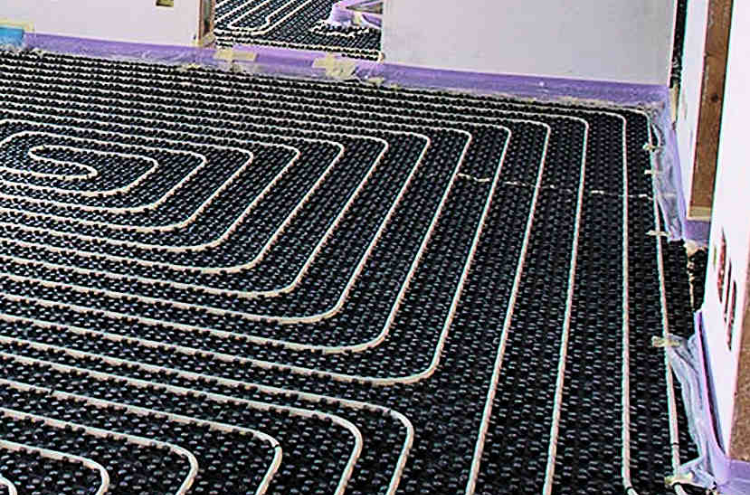How to air-condition the house all year round with maximum comfort and spending less, when fully operational, compared to classic systems
underfloor cooling
Among the many alternative proposals to cool the house while consuming as little energy as possible, there is that of underfloor cooling systems . Noises? Nobody. Dust that is raised by the action of fans and splits? Zero. Let’s find out what these systems are , and if they can also be used to heat a house . We tell you right away that, as in all air conditioning systems, there are pros and cons . One of the most interesting aspects, however, is that they allow for good energy savings .
Underfloor cooling and heating, how do they work?
If you want to have very cheap and immediate methods (turn the switch on and off) to cool a house , the answer is simple: buy yourself some fans. In this way, however, you will move the hot air, you will only cool a part of a room, you will be perpetually under a violent flow of air that is not the best of health …
On the other hand, if you are interested in a system that lasts over time and is able to cool (and heat !) The house evenly, especially if you live in it for many hours a day, read on.
Minimize the costs of electricity and gas bills, switch to another energy supplier. You can find the best rate with Tiscali Tagliacosti !
A floor cooling system is based, quite simply, on drowning a very long PVC coil of a certain diameter and according to certain criteria in the screed of an apartment (or office).
A heat source (usually an air / water reversible heat pump) will manage the temperature of the water that will flow inside this pipe. In summer, the water will be between 15 and 18 ° C, and will cool the environment by radiation. In winter, however, the water must have a temperature of just 35 ° C in order to guarantee the rooms a good climatic comfort in heating .
Radiation in underfloor cooling systems
It is a physical principle: an energy transfer takes place between two bodies with different temperatures and is achieved thanks to an exchange of heat. And it is precisely with the irradiation system that heat and coolness propagate in the coils, allowing rooms to be heated and cooled easily and uniformly (unlike simple radiators or other air-conditioning methods), even large spaces.
The best combination for maximum savings on electricity and gas bills? An underfloor system and a new energy supplier. You can find the best rate with Tiscali Tagliacosti !
How much can you save with an underfloor cooling system?
Approximately 25/30% less than traditional air conditioning systems. If we compare underfloor cooling, that is, with air conditioners placed in every room.
The reasons are to be found 1) in the fact that a single system can serve the whole house , large or small, 2) the temperature of the water necessary for the system is lower than that which would be used with other systems, 3) in the case of underfloor heating , the thermal inertia (i.e., the ability to retain heat over time) is quite high, and 4) if this system is powered by renewable sources such as photovoltaic panels, or solar panels, the savings is maximum.
Do you need a dehumidifier for an underfloor cooling system?
Yes. Some components of underfloor heating and cooling systems are made of materials, such as brass , which could cause condensation to form .
Especially in summer, when the problem of heat is given not only by high temperatures, but also by environmental humidity, it becomes essential to create a cooling system where the various elements that compose it are designed to minimize humidity and condensation .
How? Using insulated brass or stainless steel manifolds , inserting a thermoregulation system that acts on the basis of probes connected to an electronic control unit, and using a so-called “ chiller ”, which is a dehumidifier for underfloor cooling .
Underfloor cooling (and heating), the pros and cons
Each technology, however innovative and advanced, has its advantages and disadvantages. That of underfloor heating and cooling systems now makes it possible to obtain excellent performance by minimizing the negative sides. Let’s start with the pros :
– No air movement : since it is an “underground” system (drowned in the screed or in any case above the floor) it does not generate annoying drafts or movements of dust
– Uniform temperature distribution : this occurs thanks to the presence of coils in every point of the floors, allowing to avoid areas where cooling or heating is less or more
– Energy saving : we have mentioned this in the paragraphs above
– Reduced management costs compared to traditional systems
– Silence: no noise from fans or other
– Aesthetics: the system is almost invisible, for this reason it adapts to any environment, without occupying parts of the wall or protruding from the ceiling
And here are the cons :
– Initial cost for installation: it is a little higher than that of other systems, but it pays for itself largely over time. The problem is mainly due to having to dismantle the screed in order to install the coils. Today, however, there are companies that offer “non-traumatic” solutions in which the radiant panels are placed above the existing floor, with a considerable saving of costs and time for installation.
– High thermal inertia : the factor that we mentioned earlier as positive, because it is able to make us obtain a good energy saving, can also be seen from a negative angle, because it also means that to obtain a good cooling or heating quickly we takes some time. If you really want to quickly air-condition a room, it is better to resort to splits (for example). These systems are particularly suitable for environments where people stay for many hours a day
Do electricity and gas bills drain your bank account? Switch to another energy provider. You can find the best rate with Tiscali Tagliacosti !
Underfloor cooling, prices
At this point you may be wondering what are the prices for a plant of this type. The main difference in cost, between one system and another, depends on the speed with which the environment is to be cooled.
For an average underfloor cooling system you spend from 25 to 50 euros per square meter, if instead you want the top the prices can even double. Furthermore, it is also necessary to take into account the chiller (2,000 / 3,000 euros) to which we mentioned earlier, or a dehumidifier (850/1400 euros).
A good energy supplier is essential
An underfloor cooling and heating system is taken into consideration above all (but not only, given the availability of systems that can be laid over existing floors) in the context of renovations or new buildings .
An underfloor cooling system that is able to cover an entire apartment can involve a considerable outlay. Anyone who is interested, but intends to postpone its execution, still needs to save on gas and electricity bills , given the continuous, stratospheric increases.
What to do then? The best choice is to change energy supplier , to have a contract (perhaps at a fixed price for a certain period of time) that better meets our consumption needs.
In the energy market there are hundreds of operators , more or less convenient and reliable. How can you orient yourself without fear of making mistakes?
The answer consists in consulting a rate comparator, such as Tiscali Tagliacosti , who compares the offers of the best operators. No waste of time, the consultation is free and without obligation.
Better to act now, and not wait for more price increases!




